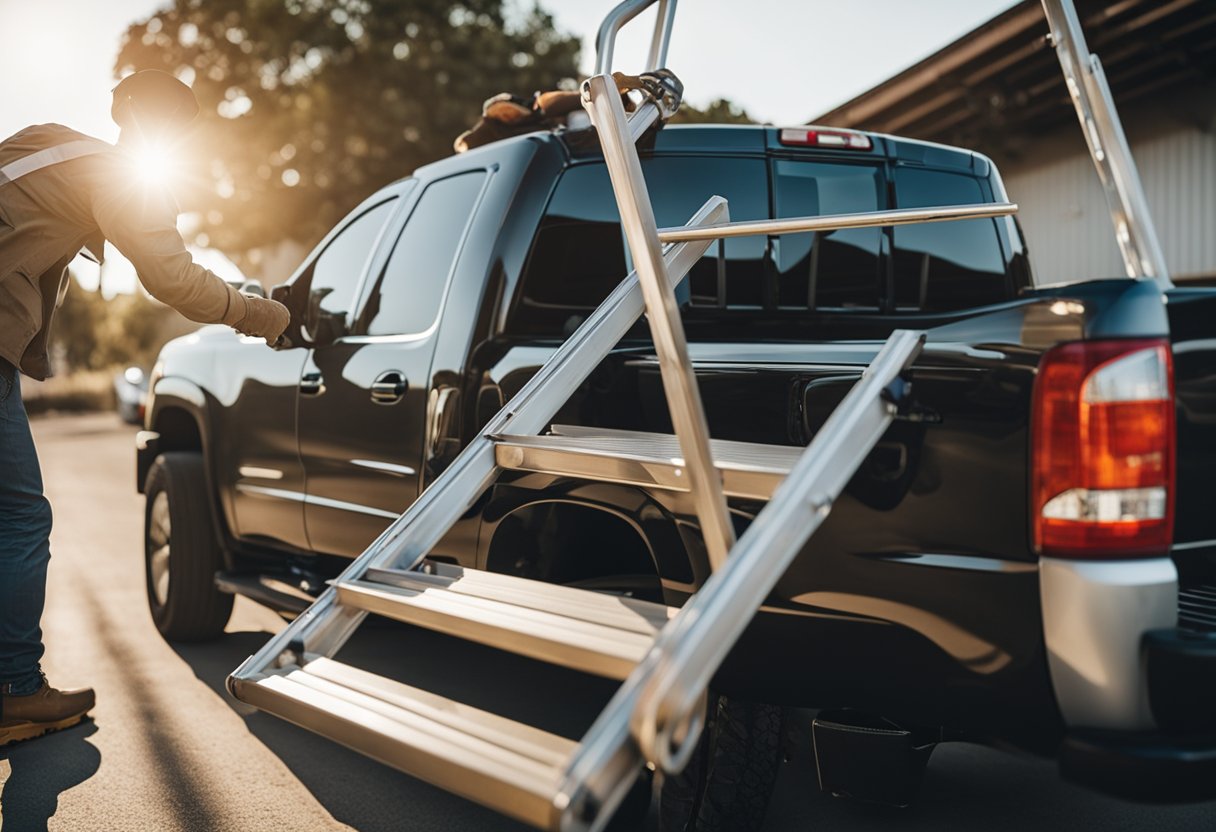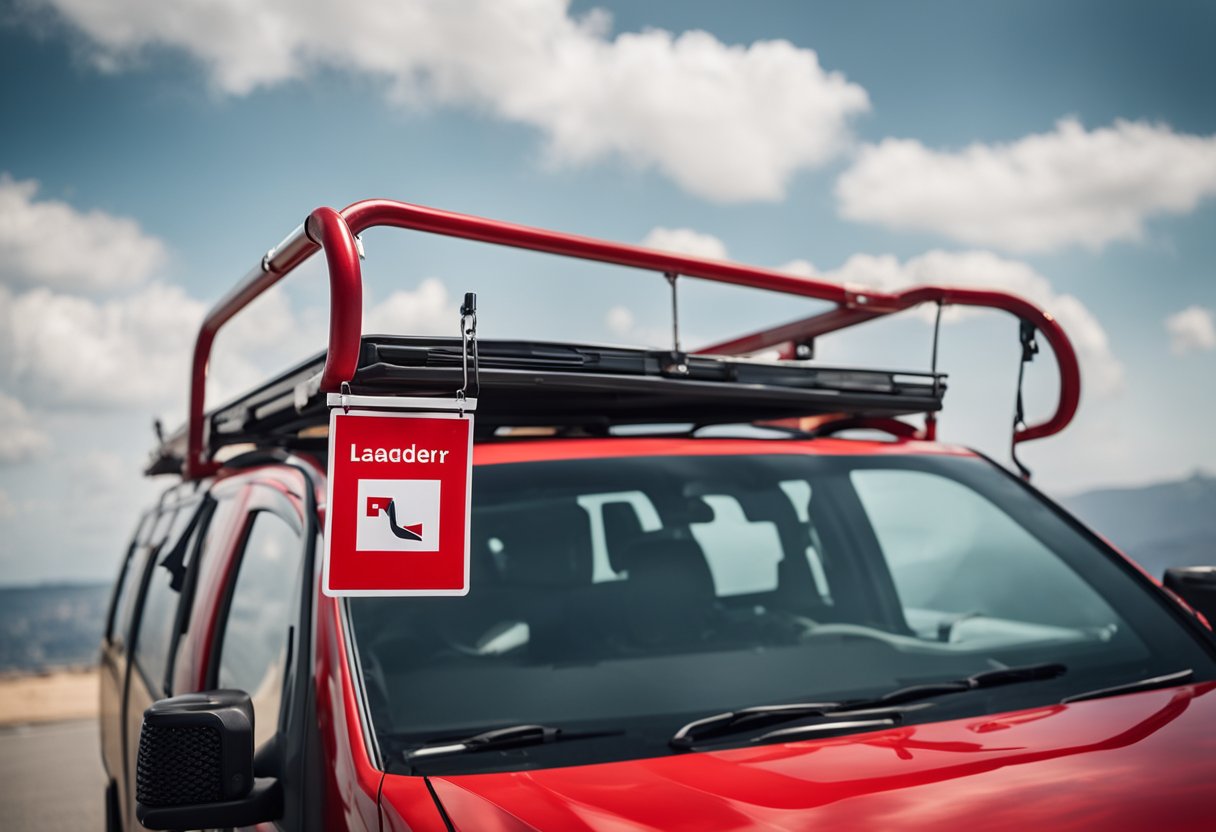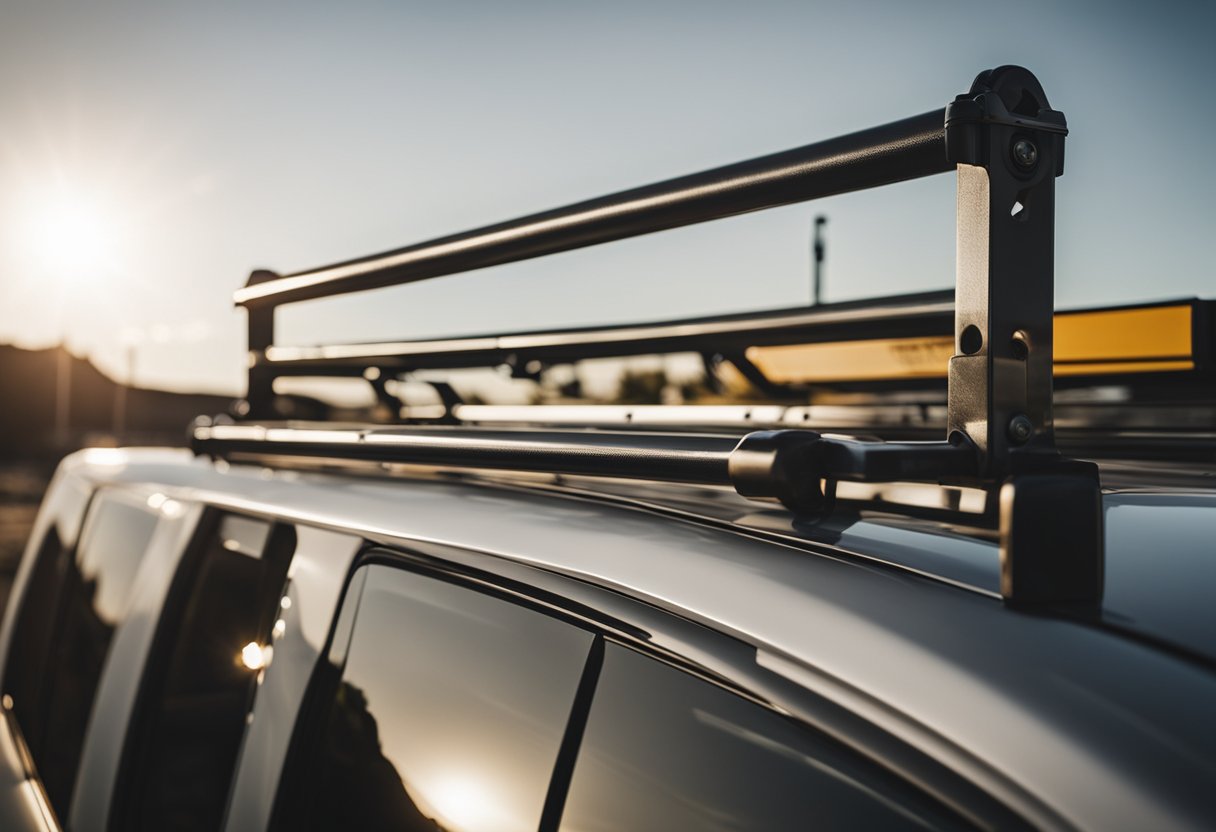Transporting a ladder from one place to another can be a daunting task, especially if you’ve never done it before. Whether you’re a professional contractor or a DIY enthusiast, knowing how to transport a ladder safely and efficiently is essential. In this article, I’ll share with you some tips and tricks on how to transport a ladder easily and securely, regardless of its size and type.
Before we dive into the details, it’s important to understand the different types and sizes of ladders and their corresponding transportation requirements. From extension ladders to step ladders, each type has its own unique features and challenges when it comes to transportation. Understanding these differences can help you choose the right vehicle and equipment for transporting your ladder, as well as ensure its safety during transit.
Key Takeaways
- Understanding the different types and sizes of ladders is crucial for safe and efficient transportation.
- Proper preparation, including securing the ladder and choosing the right vehicle and equipment, is key to successful ladder transportation.
- Following safety measures and legal requirements can help prevent accidents and ensure compliance with regulations.
Understanding Ladder Types and Sizes
As a professional handyman, I know the importance of understanding ladder types and sizes when it comes to transportation. Different ladder types and sizes require different transportation methods, so it’s essential to know what you’re dealing with to ensure a safe and secure transport.
Types of Ladders
There are two main types of ladders: step ladders and extension ladders. Step ladders are self-supporting and can be used for a variety of tasks that require a stable base. Extension ladders, on the other hand, are designed to lean against a wall or other support structure and are used for tasks that require access to higher areas. It’s important to note that extension ladders can be further classified into two types: single-section and multi-section ladders.
Ladder Sizes
Ladders come in various sizes and lengths, and it’s important to choose the right size for the job. The size of the ladder will depend on the height of the task and the reach required. Typically, ladders range from 4 feet to 32 feet in height. When choosing a ladder, it’s important to consider the weight capacity, too.
Transporting a 32-Foot Extension Ladder
Transporting a 32-foot extension ladder can be a challenge, but it’s not impossible. One option is to use a ladder rack on top of a vehicle. This method is ideal for transporting the ladder over long distances. Another option is to use a trailer hitch ladder rack. This method is ideal for shorter distances and can be easily installed on most vehicles.
Transporting a Long Ladder
Transporting a long ladder, such as a 32-foot extension ladder, requires careful planning and preparation. Before transporting the ladder, ensure that it is clean and free of any debris. Secure the ladder with tie-down straps to prevent it from shifting during transport. It’s also important to ensure that the ladder is not wider than the vehicle being used for transportation.
In summary, understanding ladder types and sizes is crucial for safe and efficient transportation. By knowing the type and size of ladder you’re dealing with, you can select the appropriate transportation method and ensure a successful transport.
Preparation for Ladder Transportation
https://www.youtube.com/watch?v=360X2wVD3E0&embed=true
Transporting a ladder can be a daunting task, but with proper preparation, it can be done safely and efficiently. Here are some essential steps to take before transporting your ladder:
Clean your ladder
Before transporting your ladder, make sure it is free of any dirt, debris, or other materials that could cause damage or make it slippery. Use a soft brush or cloth to wipe down the ladder, paying special attention to the rungs and feet.
Collapse your ladder
Collapsing your ladder is essential for safe transportation. Make sure you know how to properly collapse your ladder and that all locking mechanisms are engaged before moving it. If you have an extension ladder, collapse it to its shortest length to make it easier to transport.
Inspect your ladder
Before transporting your ladder, inspect it for any damage or wear and tear. Check the rungs, feet, and locking mechanisms for any signs of damage or malfunction. If you notice any issues, do not transport the ladder until they have been repaired.
Know the weight of your ladder
Knowing the weight of your ladder is important for selecting the right vehicle and equipment for transportation. Consult the ladder’s manual or manufacturer’s website to find its weight. Additionally, make sure the vehicle you are using to transport the ladder has a weight capacity that can handle the weight of the ladder.
By following these simple steps, you can ensure that your ladder is ready for safe and efficient transportation.
Securing the Ladder for Transportation
https://www.youtube.com/watch?v=ujLpxpMV7xw&embed=true
When it comes to transporting a ladder, securing it properly is crucial to ensure safety on the road. Here are some tips on how to secure your ladder for transportation:
Positioning the Ladder
Before securing the ladder, make sure it is positioned correctly in your vehicle. If you are using a truck, place the ladder in the bed and ensure it is centered and does not extend beyond the sides of the vehicle. If you are using a car, make sure you have enough cargo space for the ladder’s length.
Tie-Down Straps
Using tie-down straps is one of the most secure ways to transport a ladder. Ratchet straps are preferred over bungee cords as they are sturdier and can hold the ladder in place more effectively. Wrap the straps around the ladder and the vehicle, making sure they are tight and secure.
Ladder Clamps
Ladder clamps are another option for securing your ladder during transportation. They are designed to hold the ladder in place and prevent it from sliding or shifting while in transit. Make sure to choose clamps that are compatible with your ladder and vehicle, and follow the manufacturer’s instructions for proper installation.
Rope
Rope can also be used to secure your ladder during transportation. However, it is important to use a strong and durable rope that can withstand the weight of the ladder and the forces of the wind while driving. Make sure to tie the rope tightly and securely, and check it periodically during your journey to ensure it has not come loose.
By following these tips and using the appropriate equipment, you can transport your ladder safely and securely. Remember to always prioritize safety on the road, and never compromise on the quality of your equipment or the strength of your tie-downs.
Transporting a Ladder Using Different Vehicles
https://www.youtube.com/watch?v=ahbZUI7ac-Y&embed=true
Transporting a ladder can be a daunting task, especially when you have to move it using different vehicles. However, with the right tools and techniques, you can transport a ladder safely and efficiently. In this section, I will provide tips on how to transport a ladder using different vehicles such as a car, truck, van, and pickup truck.
Transporting a Ladder in a Car
Transporting a ladder in a car can be a bit tricky, but it is possible. Before you start, make sure that your car can handle the size and weight of the ladder. If you have a roof rack, you can use it to transport the ladder. Place the ladder on the roof rack with the rungs facing the side of the car. Secure the ladder to the roof rack with rope or tie-down straps. Alternatively, you can transport the ladder inside the car. Fold down the back seat and place the ladder inside the car with the bottom end resting on the floor of the car and the top end resting on the dashboard. Make sure to secure the ladder with bungee cords or tie-down straps to prevent it from moving.
Transporting a Ladder in a Truck
Transporting a ladder in a truck is relatively easy. If you have a ladder rack, place the ladder on the rack and secure it with tie-down straps. If you don’t have a ladder rack, you can place the ladder in the bed of the truck. Place the ladder horizontally in the bed of the truck and secure it with tie-down straps.
Transporting a Ladder in a Van
Transporting a ladder in a van is similar to transporting it in a truck. If you have a ladder rack, place the ladder on the rack and secure it with tie-down straps. If you don’t have a ladder rack, you can place the ladder inside the van. Make sure to fold down the seats and place the ladder on the floor of the van. Secure the ladder with tie-down straps or bungee cords to prevent it from moving.
Transporting a Ladder in a Pickup Truck
Transporting a ladder in a pickup truck is similar to transporting it in a truck. If you have a ladder rack, place the ladder on the rack and secure it with tie-down straps. If you don’t have a ladder rack, you can place the ladder in the bed of the pickup truck. Place the ladder horizontally in the bed of the truck and secure it with tie-down straps. If the ladder is too long for the bed of the truck, you can extend it over the cab of the truck. Make sure to secure the ladder with tie-down straps to prevent it from moving.
In conclusion, transporting a ladder using different vehicles requires careful planning and execution. Make sure to use the right tools and techniques to transport the ladder safely and efficiently.
Special Considerations for Ladder Racks and Roof Racks
https://www.youtube.com/watch?v=IN_GPI1IMrs&embed=true
As a professional who needs to transport a ladder frequently, it is essential to understand the different types of racks available and how to use them safely. Here are some special considerations to keep in mind when using ladder racks and roof racks.
Ladder Racks
Ladder racks are designed to carry ladders on top of a vehicle, and they come in various styles and sizes. When selecting a ladder rack, it is crucial to choose one that fits your vehicle and ladder size. Some ladder racks come with adjustable brackets that can accommodate different ladder sizes, while others are designed for specific ladder sizes.
If you are using a ladder rack, make sure to secure the ladder with straps or bungee cords. It is also essential to load the ladder correctly to prevent it from shifting while driving. Always center the ladder on the rack and make sure it does not extend beyond the sides of the vehicle.
Roof Racks
Roof racks are another option for transporting ladders. They are designed to carry a wide range of items, including ladders, and they come in various styles and sizes. When selecting a roof rack, it is crucial to choose one that fits your vehicle and can accommodate the weight of your ladder.
If you are using a roof rack, make sure to secure the ladder with straps or bungee cords. It is also essential to load the ladder correctly to prevent it from shifting while driving. Always center the ladder on the rack and make sure it does not extend beyond the front or back of the vehicle.
Transporting a Ladder Without a Roof Rack
If you do not have a ladder rack or roof rack, there are still ways to transport a ladder safely. One option is to use a ladder clamped to the side of your van roof. Ladder clamps are designed to securely fit almost any ladder to your existing vehicle roof rack, in a quick and simple way while being highly durable.
Another option is to place the ladder inside the vehicle. To do this, you will need to fold the ladder and secure it with bungee cords or straps. Make sure to place the ladder on a non-slip surface, such as a rubber mat, to prevent it from sliding around while driving.
In conclusion, when transporting a ladder, it is essential to choose the right rack for your vehicle and ladder size. Always secure the ladder with straps or bungee cords and load it correctly to prevent it from shifting while driving. By following these simple tips, you can transport your ladder safely and efficiently.
Loading and Unloading the Ladder
https://www.youtube.com/watch?v=1Tf-U57d6Oo&embed=true
When it comes to transporting a ladder, loading and unloading it from your vehicle can be a challenging task. However, with proper planning and execution, it can be done safely and efficiently. In this section, I will guide you through the process of loading and unloading your ladder.
Loading the Ladder
Before loading your ladder onto your vehicle, make sure that the ladder is clean and free of any debris or dirt. This will prevent any scratches or damage to your vehicle’s surface. It is also recommended to protect your ladder by cushioning it with foam padding or a blanket.
When loading your ladder, always make sure that it is parallel to the sides of your vehicle. This will ensure that the ladder is stable and will not move during transportation. You can secure the ladder using tie-down straps or bungee cords. Make sure that the ladder is tied down securely to prevent any accidents during transportation.
Unloading the Ladder
When unloading your ladder, make sure that you protect your ladder and your vehicle from any damage. It is recommended to have a helper to assist you in unloading the ladder. This will prevent any accidents or injuries.
To unload the ladder, simply reverse the process of loading the ladder onto your vehicle. Make sure that the ladder is parallel to the sides of your vehicle and that it is cushioned with foam padding or a blanket. Carefully remove the tie-down straps or bungee cords and gently lower the ladder to the ground.
In conclusion, loading and unloading a ladder can be done safely and efficiently with proper planning and execution. Protecting and cushioning your ladder, securing it with tie-down straps or bungee cords, and ensuring that it is parallel to the sides of your vehicle are essential steps to transport your ladder safely.
Safety Measures and Legal Requirements
Transporting a ladder can be a risky task if not done safely and legally. It is important to take necessary precautions to prevent road accidents and ensure traffic safety. Here are some safety rules and legal requirements that you should consider when transporting a ladder:
Secure the Ladder Properly
Before you start driving, make sure that the ladder is securely fastened to your vehicle. According to Ladder Bible, you should lift the ladder onto your roof and firmly secure it to the vehicle. The ladders should sit lengthways, running perpendicular to your wheel axles, on top of the roof rack or in the bed of your truck. Use straps or bungee cords to tie the ladder down and prevent it from shifting or falling off while driving.
Follow Legal Requirements
It is important to follow legal requirements when transporting a ladder. According to the American Ladder Institute, the ladder should not extend more than 3 feet above the edge of the vehicle. If the ladder extends beyond the rear of the vehicle, it should be marked with a red flag or cloth. Make sure that the ladder does not obstruct your view or the view of other drivers.
Check Your Vehicle
Before transporting a ladder, it is important to check your vehicle to ensure that it is in good condition. According to Safety Culture, you should check your vehicle’s tire pressure, brakes, and suspension. Make sure that your vehicle is capable of carrying the weight of the ladder and any additional equipment.
Drive Safely
When transporting a ladder, it is important to drive safely and follow traffic rules. Keep a safe distance from other vehicles and avoid sudden stops or turns. Be aware of your surroundings and adjust your driving according to weather conditions. If you feel tired or dizzy, take a break and rest before continuing your journey.
By following these safety measures and legal requirements, you can safely transport a ladder without putting yourself or others at risk. Always remember to take necessary precautions and drive responsibly to prevent road accidents.
Efficient Space Management and Positioning
As a professional who has transported many ladders, I understand the importance of efficient space management and proper positioning. Not only does it ensure the safety of the ladder during transportation, but it also maximizes your work efficiency by allowing you to carry other tools and equipment.
When transporting a ladder in a car trunk, it’s essential to clear as much space as possible. I recommend folding down the back seat and sliding the front passenger seat forward to create enough room for the ladder. Make sure to secure the ladder with bungee cords or tie-down straps to prevent it from sliding around during transportation.
If you’re using a pickup truck, consider using a ladder rack or roof rack to maximize your space. You can also position the ladder vertically against the tailgate, securing it with bungee cords or tie-down straps. This will allow you to carry other tools and equipment in the bed of the truck.
When positioning the ladder, make sure it’s stable and secure. Avoid placing it in a way that obstructs your view while driving or interferes with the operation of the vehicle. Always check the ladder’s position before driving off to ensure it’s properly secured.
Efficient space management and positioning are crucial when transporting a ladder. By following these tips, you can ensure the safety of the ladder during transportation and maximize your work efficiency.
Conclusion
In conclusion, transporting a ladder safely is a crucial aspect of ladder usage. It is important to ensure that the ladder is secured properly and that the vehicle being used can handle the weight and size of the ladder.
When transporting a ladder, it is recommended to use a ladder rack or roof rack if available. This will help to secure the ladder and prevent it from moving around during transport. If a ladder rack is not available, the ladder can be transported in the bed of a pickup truck. It is important to lay the ladder horizontally and secure it with straps or bungee cords.
When transporting an extension ladder, it is important to measure both the ladder and the truck bed to ensure that the ladder will fit properly. It is also recommended to use a ladder rack or roof rack if available, or to secure the ladder in the bed of a pickup truck with straps or bungee cords.
In addition to securing the ladder during transport, it is important to follow safe techniques when loading and unloading the ladder. Always have a second person to assist with lifting and moving the ladder, and never carry the ladder vertically. Always carry the ladder horizontally, with one end resting on your shoulder and the other end supported by your hand.
By following these tips and techniques, you can transport your ladder safely and with confidence. Remember to always prioritize safety when handling and transporting your ladder.
Frequently Asked Questions
What is the maximum length of ladder that can fit in a car?
The maximum length of ladder that can fit in a car depends on the size of the car and the length of the ladder. In general, a ladder that is up to 8 feet in length can fit in most cars. However, if you have a larger car or a roof rack, you may be able to transport a longer ladder. It is important to measure the ladder and the car before attempting to transport the ladder.
How do you secure a ladder to a car roof?
To secure a ladder to a car roof, you can use rope, bungee cords, or ladder clamps. It is important to make sure that the ladder is secured tightly to prevent it from moving during transportation. If you are using rope or bungee cords, make sure that they are tied securely and that the ladder is not able to move. If you are using ladder clamps, make sure that they are tightened properly and that the ladder is secured in place.
What are the best ladder clamps for transportation?
The best ladder clamps for transportation are those that are designed specifically for securing ladders to vehicles. Some popular brands include Rhino Rack, Thule, and Yakima. When choosing ladder clamps, make sure that they are compatible with your vehicle and that they are able to securely hold your ladder in place.
How do you transport a 28-foot extension ladder?
Transporting a 28-foot extension ladder can be challenging, especially if you do not have a large vehicle or a roof rack. One option is to rent a truck or a trailer to transport the ladder. Another option is to use ladder clamps to secure the ladder to the roof of your vehicle. It is important to make sure that the ladder is secured tightly and that it does not extend beyond the front or rear of the vehicle.
What is the safest way to transport a ladder on a vehicle?
The safest way to transport a ladder on a vehicle is to use a roof rack and ladder clamps. This will help to ensure that the ladder is secured tightly and that it does not move during transportation. It is important to make sure that the ladder is not extending beyond the front or rear of the vehicle and that it is not blocking any windows or mirrors.
How do you transport a 12-foot step ladder in a small car?
Transporting a 12-foot step ladder in a small car can be challenging, but it is possible. One option is to fold the ladder in half and place it in the trunk of the car. Another option is to use a roof rack and ladder clamps to secure the ladder to the roof of the car. It is important to make sure that the ladder is secured tightly and that it does not move during transportation.

Hi, I’m Sal Muller of Tooltrip.com. My DIY experience led me to understand essential power tools for home projects. Tooltrip.com guides enthusiasts and professionals in choosing right tools for any job. I provide concise top tool reviews for easier, efficient DIY.







